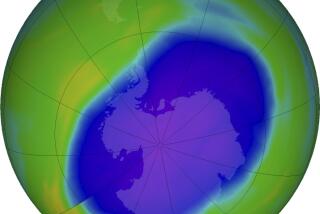Ozone Loss Over Arctic Being Explored
- Share via
STAVANGER, Norway — American and European scientists using a modern version of the U-2 spy plane are setting out to explore troubling signs of ozone loss high over the Arctic.
The project, organized by the National Aeronautics and Space Administration, runs from Jan. 1 to mid-February, the period when a hole apparently opens up in the protective ozone layer at the top of the world.
Most of the scientists are veterans of a 1987 expedition that documented an ozone hole over Antarctica during the southern winter.
“The ozone hole over Antarctica is something you can’t miss,” said Dr. Adrian Tuck, a chemist and meteorologist. “We did come up with an unequivocal answer that the ozone hole was indeed caused by man-made chemicals, and a natural question to ask is: ‘Is it possible in the Arctic?’ ”
Scientists fear that the loss of ozone, a gas which filters the sun’s harmful ultraviolet rays, is leading to increased skin cancer and eye damage and could upset the food chain by harming many species of plants and animals.
Dr. Darrell S. Rigel, a U.S. dermatologist, recently reported a 1,500% increase in melanoma, a form of skin cancer, in the United States since 1935, with more people contracting the disease at a younger age.
Tuck and other scientists gathering at Sola, a Norwegian air force base here, said that the Arctic hole appears to be smaller than the southern one but that it could be more serious because it is closer to where people live.
“If the changes occur, they could probably have an effect over a much larger area, due to the difference in meteorology,” said Ivar Isaksen, a professor at the University of Oslo. “There’s a much larger exchange of air.
“The idea here is to look at what happens not only in the vortex, but what consequences it could have for the ozone at lower latitudes.”
The vortex is a circulation of strong westerly winds in the polar region.
The scientists will analyze clouds about 12 miles up that “in a manner that was completely unpredicted . . . can intervene in the chemistry, change the chemical balance, and make it easier for the chlorine from refrigerants and aerosol can sprays and so on to destroy the ozone,” said Tuck.
Four pilots will take turns flying through the clouds in a single-engine ER-2, an updated model U-2, loaded with scientific instruments. A modified DC-8 airliner will look at the clouds from below with lasers and other instruments.
The missions will mostly be north and west of Norway, but will avoid Soviet air space, said pilot Jim Barrileaux of Dublin, Calif. He said the Soviets might be sending up research flights of their own over northern Siberia.
The Norwegian air force cleared out a sprawling hangar at its seaside base to make room for the ER-2. An advance team nailed together Sheetrock partitions as temporary offices, and computer experts patched together a network for data analysis and weather reports beamed down by satellite.
It could take as long as a year to analyze the data and publish a full report, Estelle Condon, the project manager, said.
Worry about ozone depletion led last year to industrial nations’ signing a treaty to reduce the use of the chlorofluorocarbon chemicals that are primary suspects in ozone destruction. Further steps are under consideration.
“We have information from the southern hemisphere, and so we would like information from the northern hemisphere, so when the negotiations take place they have the best information possible to make the decisions,” said Condon.
The project’s $10 million budget is “not very big by NASA standards,” she said. Up to 150 scientists will take part, most of them from the United States. Britain, Norway and West Germany also are represented.
The mission’s success will depend largely on the weather, said Tuck. The clouds could drift over the Soviet Union, or they may not form at all, though 1985 was the only year in the last decade when that happened.






